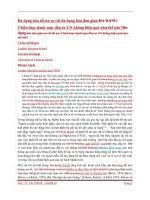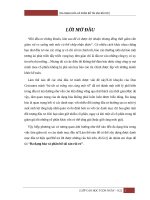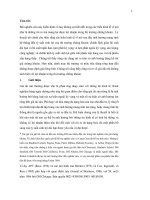Tiểu luận môn đầu tư tài chính monetary police theory
Bạn đang xem bản rút gọn của tài liệu. Xem và tải ngay bản đầy đủ của tài liệu tại đây (2.91 MB, 99 trang )
The economics of Money, Banking and Financial Markets
Chapter 24: Moneytary
Policy Theory
Học viên: Trần Thị Thanh Thủy
Võ Thị Trúc Xuân
Lớp: TC03 GV hướng dẫn: TS Trần Ngọc Thơ
University
LOGO of Economics Ho Chi Minh City
Structure
-
Preview
Response of Monetary Policy to Shocks
Application: Quantitative (Credit) Easing in Response to the Global Finamcial Crisis
How Actively Should Policymakers Try To Stabilze Economic Activity?
Inflation: Always and Everywhere – A Monetary Phenomenon
Causes Of Inflationary Monetary Policy
Application: The Great Inflation
Summary
Expansion
Preview
Inflation has become a major concern of politicians and the public, and how to control it frequently dominates the
discussion of economic policy.
In this chapter, we use the aggregate demand–aggregate supply (AD/AS) framework developed in Chapter 22 to
develop a theory of monetary policy. Specifically, we will examine the role of monetary policy in creating inflation and
stabilizing the economy.
We apply the theory to three big questions:
-
What are the roots of inflation?
Does stabilizing inflation stabilize output?
Should policy be activist—by responding aggressively to fluctuations in economic activity—or passive and
nonactivist?
Response of Monetary Policy to Shocks
e central goal of central banks is price stability: that is, they try to maintain inflation,,
•close Th
to a target level (), referred to as an inflation target, that is slightly above zero. Most central
banks set between 1% and 3%.
An alternative way to think about how the central bank pursues price stability is that
monetary policy should try to minimize the difference between inflation and the inflation target
( - ), which we refer to as the inflation gap.
Response of Monetary Policy to Shocks
Central banks also care about stabilizing economic activity.
Because economic activity can be sustained only at potential
output, this objective of monetary policy can be described as
saying that monetary policymakers want to have aggregate output
close to its potential level, YP. Another way of saying this is that
central banks want to minimize the difference between aggregate
output and potential output (Y − YP), i.e., the output gap.
Response of Monetary Policy to Shocks
we examined three categories of economic shocks—demand shocks,
temporary supply shocks, and permanent supply shocks—and the
consequences of each on inflation and output.
In this section, we describe a central bank’s policy responses, given its
objectives, to each of these shocks. In the case of both demand shocks
and permanent supply shocks, policymakers can simultaneously pursue
price stability and stability in economic activity.
Following a temporary supply shock, however, policymakers can
achieve either price ability or economic activity stability, but not both.
This tradeoff poses a thorny dilemma for central banks with dual andates.
Response to an Aggregate Demand Shocks
•W
e begin by considering the effects of an aggregate demand
shock, such as the disruption to financial markets starting in
August 2007 that increased financial frictions and caused both
consumer and business spending to fall.
The economy is initially at point 1, where output is at YP and
inflation is at . The negative demand shock decreases aggregate
demand, shifting AD1 in Figure 1 to the left to AD2.
Policymakers can respond to this shock in two possible ways
Response to an Aggregate Demand Shocks
•
No Policy Response
Because the central bank does not respond by changing the
autonomous component of monetary policy, the aggregate
demand curve remains at AD2 and so the economy goes to the
intersection of AS1 and AD2.
Here, aggregate output falls to Y2 below potential output YP,
and inflation falls to 2, below the inflation target of T
Response to an Aggregate Demand Shocks
LRAS
1
2
3
Response to an Aggregate Demand Shocks
No Policy Response
With output below potential, slack begins to develop in the labor and product
markets, lowering inflation. The short-run aggregate supply curve will shift down
and to the right to AS3, and the economy will move to point 3. Output will again
be back at its potential level, while inflation will fall to a lower level of π 3.
At first glance, this outcome looks favorable—inflation is lower and output is
back at its potential. But aggregate output will remain below potential for some
time, and if inflation was initially at its target level, the fall in inflation is
undesirable.
Response to an Aggregate Demand Shocks
No Policy Stabilizes Economic Activity And Inflation in the Short Run
Policymakers can eliminate both the output gap and the inflation gap in the short run
bypursuing policies to increase aggregate demand to its initial level and return the
economy to its preshock state. The central bank does this by autonomously easing
monetary policy by cutting the real interest rate at any given inflation rate.
This action stimulates investment spending and increases the quantity of aggregate
output demanded at any given inflation rate, thereby shifting the AD curve to the
right. As a result, the aggregate demand curve shifts from AD2 back to AD1 in Figure
2, and the economy returns to point 1.
Response to an Aggregate Demand Shocks
No Policy Stabilizes Economic Activity And Inflation in the Short Run
Our analysis of this monetary policy response shows that in the case of
aggregate demand shocks, there is no tradeoff between the pursuit of price
stability and economic activity stability. A focus on stabilizing inflation leads to
exactly the right monetary policy response to stabilize economic activity.
No conflict exists between the dual objectives of stabilizing inflation and
economic activity, which Olivier Blanchard (formerly of MIT, but now at the
International Monetary Fund) referred to as the divine coincidence.
Response to an Aggregate Demand Shocks
LRAS
1, 3
2
Application: Quantitative (Credit) Easing in Response to the Global Finamcial Crisis
After the Lehman Brothers collapse, the real cost of borrowing to both households and businesses shot up because
financial frictions rose dramatically ( fc ).
The higher real cost of borrowing led to a decline in consumption expenditure and planned investment spending,
thereby causing a sharp contraction in aggregate demand and a leftward shift of the aggregate demand curve to AD2, as in
Figure 2.
Although the Federal Reserve autonomously lowered the federal funds rate to the zero-lower bound, this was
insufficient to shift the aggregate demand curve back to AD1. By engaging in asset purchases and liquidity provision, the
Fed was able to reduce financial frictions ( fT ) and lower the real cost of borrowing to households and businesses.
Application: Quantitative (Credit) Easing in Response to the Global Finamcial Crisis
The result was that the aggregate demand curve did shift out to the right as shown in Figure 2,
thereby avoiding deflation and boosting economic activity so that the economy did not enter a
depression, as in the 1930s.
However, the negative aggregate demand shock to the economy from the global financial crisis
was so great that the Fed’s quantitative (credit) easing was insuffi-cient to overcome it, and the Fed was
unable to shift the aggregate demand curve all the way back to AD1.
Hence, despite the Federal Reserve’s efforts, the economy still suffered a severe recession, with
inflation falling below the 2% level.
Application: Quantitative (Credit) Easing in Response to the Global Finamcial Crisis
•
Response
to a permanent Supply Shock
We illustrate a permanent supply shock in Figure 3. Again the economy starts out at point
1, where aggregate output is at the natural rate YP1 and inflation is at .
Suppose the economy suffers a permanent negative supply shock because an increase in
regulations permanently reduces the level of potential output. Potential output falls from YP1 to
YP 3, and the long-run aggregate supply curve shifts leftward from LRAS1 to LRAS3.
The permanent supply shock triggers a price shock that shifts the short-run aggregate
supply curve upward from AS1 to AS2. Two possible policy responses to this permanent supply
shock are possible
Application: Quantitative (Credit) Easing in Response to the Global Finamcial Crisis
Response to a permanent Supply Shock
No Policy Response
If policymakers leave autonomous monetary policy un- changed, the economy will move to point
2, with inflation rising to p2 and output falling to Y2.
Because this level of output is still higher than potential output, YP3, the short-run aggregate
supply curve keeps shifting up and to the left until it reaches AS3, where it intersects AD1 on LRAS3.
The economy moves to point 3, eliminating the output gap but leaving inflation higher at π 3 and
output lower at YP3.
Application: Quantitative (Credit) Easing in Response to the Global Finamcial Crisis
•
Response
to a permanent Supply Shock
No Policy Response
We illustrate a permanent supply shock in Figure 3. Again the economy starts out at point
1, where aggregate output is at the natural rate YP1 and inflation is at .
Suppose the economy suffers a permanent negative supply shock because an increase in
regulations permanently reduces the level of potential output. Potential output falls from YP1 to
YP 3, and the long-run aggregate supply curve shifts leftward from LRAS1 to LRAS3.
The permanent supply shock triggers a price shock that shifts the short-run aggregate
supply curve upward from AS1 to AS2. Two possible policy responses to this permanent supply
shock are possible
Application: Quantitative (Credit) Easing in Response to the Global Finamcial Crisis
LRAS3
LRAS1
3
2
1
Application: Quantitative (Credit) Easing in Response to the Global Finamcial Crisis
Response to a permanent Supply Shock
Policy Stabilizes Inflation
According to Figure 4, monetary authorities can keep inflation at the target
inflation rate and stabilize inflation by decreasing aggregate demand.
The goal is to shift the aggregate demand curve leftward to AD3, where it
intersects the long-run aggregate supply curve LRAS3 at the target inflation rate
of πT. To shift the aggregate demand to AD3, the monetary authorities would
autonomously tighten monetary policy by increasing the real interest rate at any
given inflation rate, thus causing investment spending to fall and lowering
aggregate demand at any given inflation rate.
The economy thus goes to point 3, where the output gap is zero and
inflation is at the target level of πT.
Application: Quantitative (Credit) Easing in Response to the Global Finamcial Crisis
Response to a permanent Supply Shock
Policy Stabilizes Inflation
Here again, keeping the inflation gap at zero leads to a zero output gap, so
stabilizing inflation has stabilized economic activity.
The divine coincidence still remains true when a permanent supply shock occurs:
There is no tradeoff between the dual objectives of stabilizing inflation and economic
activity.
Application: Quantitative (Credit) Easing in Response to the Global Finamcial Crisis
LRAS3
LRAS1
2
1
3
1
Application: Quantitative (Credit) Easing in Response to the Global Finamcial Crisis
Response to a temprorary Supply Shock
When a supply shock is temporary, such as when the price of oil surges because of
political unrest in the Middle East or because of an act of god, such as a devastating hurricane in
Florida, the divine coincidence does not always hold.
Policymakers face a short-run tradeoff between stabilizing inflation and economic
activity. To illustrate, we start the economy at point 1 in Figure 5, where aggregate output is at
the natural rate YP and inflation is at πT.
Application: Quantitative (Credit) Easing in Response to the Global Finamcial Crisis
Response to a temprorary Supply Shock
The negative supply shock, say, a rise in the price of oil, shifts the short-run aggregate
supply curve up and to the left from AS1 to AS2 but leaves the long-run aggregate supply curve
unchanged because the shock is temporary.
The economy moves to point 2, with inflation rising to π 2 and output falling to Y2.
Policymakers can respond to the temporary supply shock in three possible ways.
Application: Quantitative (Credit) Easing in Response to the Global Finamcial Crisis
Response to a temprorary Supply Shock
No Policy Response
One policy choice is not to make an autonomous change in monetary policy, so the aggregate demand
curve does not shift.
Since aggregate output is less than potential output YP, eventually the short-run
aggregate
supply
curve
will
shift
back down to the right, returning to AS1.
The economy will return to point 1 in Figure 5 and close both the output and inflation gaps, as output and
inflation return to the initial levels of YP and πT









